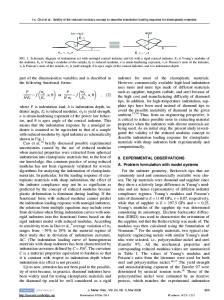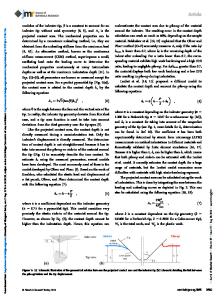On the indentation contact area of a creeping solid during constant-strain-rate loading by a sharp indenter
- PDF / 200,876 Bytes
- 7 Pages / 585 x 783 pts Page_size
- 0 Downloads / 350 Views
Michael V. Swain Biomaterials Unit, Department of Oral Sciences, School of Dentistry, University of Otago, Dunedin, New Zealand; Biomaterials Science Research Unit, Faculty of Dentistry, University of Sydney, United Dental Hospital, Surry Hills, NSW 2010, Australia; and School of Aerospace, Mechanical & Mechatronic Engineering, University of Sydney, Sydney, NSW 2006, Australia (Received 19 February 2006; accepted 7 June 2006)
Poly(methyl methacrylate) was contacted by a Berkovich indenter at a range of constant loading strain rates. This particular loading scheme was used to maintain the strain-rate-dependent elastic modulus and indentation hardness of the creeping solid constant throughout loading. A loading curve analysis method identical to that of Malzbender and de With but based on the elastic-perfectly plastic contact model of Hochstetter et al. [Tribol. Int. 36, 973–985, 2003] was used to process the load-displacement curves. Using the analysis method together with the strain-rate-dependent elastic modulus of the creeping solid known a priori, the strain-rate-dependent hardness could then be predicted. The predicted hardness versus strain-rate relationship was compared with that evaluated from the observed topographic images of the residual impressions due to heavier indentations at three constant loading strain rates. Based on this comparison, the elastic-perfectly plastic contact model was shown to be applicable to the creeping solid only when deformation takes place at a quasi-static strain rate.
I. INTRODUCTION
Instrumented indentation is a widely accepted technique for determining the local mechanical properties of a material from its measured indentation loaddisplacement response.1 While developed originally for a material the mechanical response of which is independent of indentation time scales used, the technique is used increasingly for time-dependent and rate-dependent materials. In this technique, the indentation hardness or the mean contact pressure, H, and the reduced elastic modulus, Er, of a material are determined as H=
P , A
Er =
公 S 2公A
(1)
and ,
(2)
a)
Address all correspondence to this author. e-mail: [email protected] DOI: 10.1557/JMR.2007.0135 J. Mater. Res., Vol. 22, No. 4, Apr 2007
http://journals.cambridge.org
Downloaded: 16 May 2014
respectively, where P is the load at which the material surface is pressed by an indenter, and A is the projected area of contact at that load. S is the elastic stiffness of contact, which is determined commonly as the slope of the load-displacement curve at the onset of unloading on the assumption that the unloading response is predominantly elastic.  is a constant associated with the geometry of the indenter. Er is related to the Poisson’s ratio, , and the elastic modulus, E, of the material through the relationship 1 Ⲑ Er = 共1 − 2兲 Ⲑ E + 共1 − 21兲 Ⲑ Ei, where i and Ei are the Poisson’s ratio and elastic modulus of the indenter. A is determined as a function of the depth of contact hc based on the knowledge of the indenter
Data Loading...











